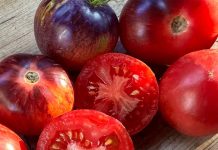As a child, I never really understood the fascination with pushing parts into a real potato, so Mr. Potato Head usually sat eyeless, earless and mouthless as I meandered over to my brother’s Lego or Lincoln Log sets.
But I do remember eating yummy potatoes, and being born to a German father allowed me a whole array of potato cuisine. German hot potato salad, potato pancakes, and potato dumplings were all favorites growing up, and no doubt that’s where my love for potatoes probably began.
Yet potatoes have received such a bad rap. Alive with many vitamins, minerals and an assortment of phytochemicals such as carotenoids and natural phenols, these tuberous roots are ignored as a nutritious meal.
Stockpiled in carbohydrates under various colored skins, they have been villianized for their alleged contribution to weight gain and a high glycemic index (GI). It all began when potatoes lost their appeal during the Atkins diet rage in 2004, and people have kept to the notion potatoes are fattening, not nutritious or important to a balanced diet.
Blame for putting on the pounds actually goes to butter, cheese and sour cream that typically lands in the potato.
Luckily, change happens, and this wonderful complex carbohydrate is making its way back into daily meals. Recent studies show that including potatoes in a healthy diet rich in vegetables, fruits, legumes and whole grains is perfectly ok and that diabetics need not be so wary. Blood sugar does not spike crazily when eating it.
Problems occur on how the potatoes are prepared, and it comes as no surprise that frying potatoes is not good and not just because of free radicals looming in every bite. The way it’s cooked makes the difference. Baking or roasting gives the potato a lower GI than frying. Eating it after its been refrigerated even lowers the index. And eating it with the skin adds fiber, a good way to keep insulin levels stable.
The palatable potato has only 130 to 140 calories and a good source of potassium and vitamin C. And though part of the family of nightshades that seems to have an adverse affect on those ultra sensitive to its alkaloids, the potato provides beneficial bulk in the form of a resistant type of starch impervious to enzymatic breakdown in the stomach and small intestines.
The physiological effects and health benefits of this starch mimic those of fiber and offers protection against colon cancer, improves glucose tolerance and insulin insensitivity, lowers plasma cholesterol and triglyceride concentrations, increases satiety and possibly even reduces fat storage.
Domesticated in now modern-day Peru, a small diversity of potatoes made their way to Europe via the Spaniards in the mid 16th century. And though slow to adapt, by the 19th century the humble potato played an important part in the European population boom. It has now became an important food staple worldwide, playing a big role in the world’s food supply.
As one of the most versatile vegetables available for cooking, many recipes have sprouted up around the mighty spud.
What are the healthiest ways to cook a potato? Baking it with the skin on leaves the fats out of the picture, just wrap in foil and place in a heated oven. Boiling cut potatoes (skin intact) in natural herbs like oregano, ginger or mint is also a novel way to cook it. The benefits of the herbs are absorbed by the boiled potatoes, making the nutrient value richer.
Grill it, sauté it or put it into soups, just be mindful of the fats. My favorite of course is placing a wrapped garlic bulb in the oven within the last few minutes of baking the potato. With the cooked potato done and split open, I squeeze the meaty part of the cooked cloves into my potato with a slice of avocado to top it off.
Tasty, nutritious and economical, the potato is certainly climbing the charts in the ranks of healthy foods.




